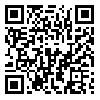

Volume 18, Issue 1 (2012; Vol. 18, No. 2 2012)
Intern Med Today 2012, 18(1): 75-81 |
Back to browse issues page
Download citation:
BibTeX | RIS | EndNote | Medlars | ProCite | Reference Manager | RefWorks
Send citation to:



BibTeX | RIS | EndNote | Medlars | ProCite | Reference Manager | RefWorks
Send citation to:
Amiri M, Chamani R, Bagheri H, Sadeghian F, khosravi A. Cost Analysis and Per capita Performance of the Staff Working in Hygiene Sectors of Shahroud University of Medical Sciences . Intern Med Today 2012; 18 (1) :75-81
URL: http://imtj.gmu.ac.ir/article-1-820-en.html
URL: http://imtj.gmu.ac.ir/article-1-820-en.html
1- , M_AMIRI_71@YAHOO.COM
Abstract: (10261 Views)
Abstract
Background and Aim: Calculating per capita performance is a logical and reasonable basis for the diagnosis of staff’s competency and merits and for achieving organizational objectives. This study aimed at analyzing the costs and determining the per capita performance of the personnel working in the hygiene sectors of Shahroud University of Medical Sciences.
Materials and Methods: In this descriptive cross-sectional study, all the costs of the sectors affiliated with the Health Deputy of Shahroud University of Medical Sciences were extracted in 2009. The services and activities were standardized and the time required for the performance of each activity was determined through using service provider comments. The primary health cares were provided based on the methods recommended in the reviewing and program evaluation techniques. The data were collected through over 75 forms and were fed into Excel and the cost analysis software. After analyzing the data, the results were displayed in frequency distribution tables and charts.
Results: 44.4% of the participants were males. Useful work time per capita in health houses were 270 minutes per day, in rural health centers it was 214 minutes, in urban health centers it was 203 minutes, in urban boarding health centers it was 343 minutes, and in health posts, it was 168 minutes. The useful work time per capita for the whole city employees was 225 minutes per day. The available workforce received 459 Rials for each minute of required work and 854 Rials for each minute of useful work.
Conclusion: Only half of the temporal capacity of rural health workers, health technicians, administrative staff, and the diagnostic and therapeutic personnel were efficiently used, while for the temporary capacity and delivery and labor facilities of health posts, this figure stood at less than one third. Professional enrichment, clarifying work processes and workforce adjustment can play an important role in increasing productivity.
Type of Study: Original |
Subject:
Laboratory Medicine
Received: 2010/08/9 | Accepted: 2012/05/2 | Published: 2012/04/15
Received: 2010/08/9 | Accepted: 2012/05/2 | Published: 2012/04/15
| Rights and permissions | |
 |
This work is licensed under a Creative Commons Attribution-NonCommercial 4.0 International License. |


